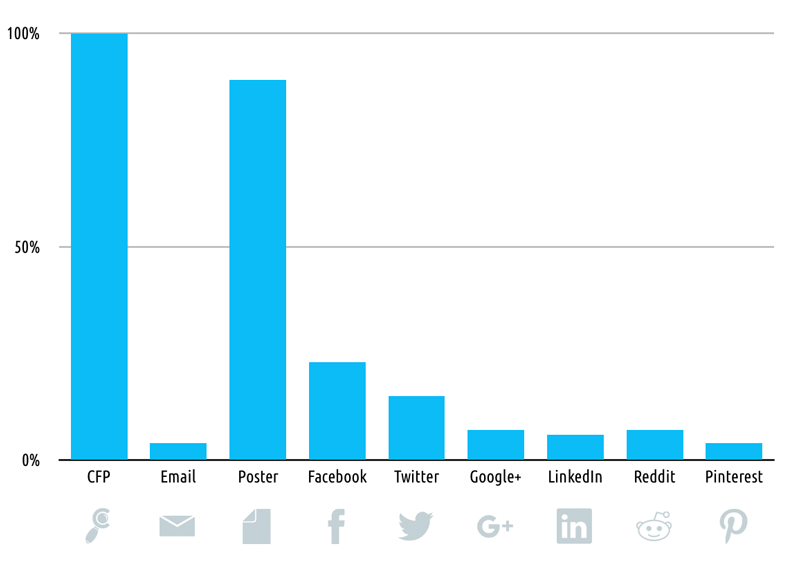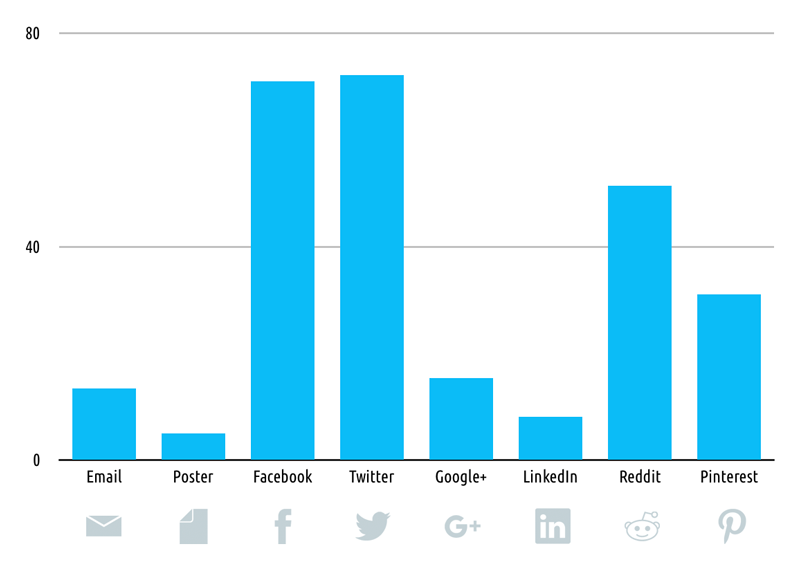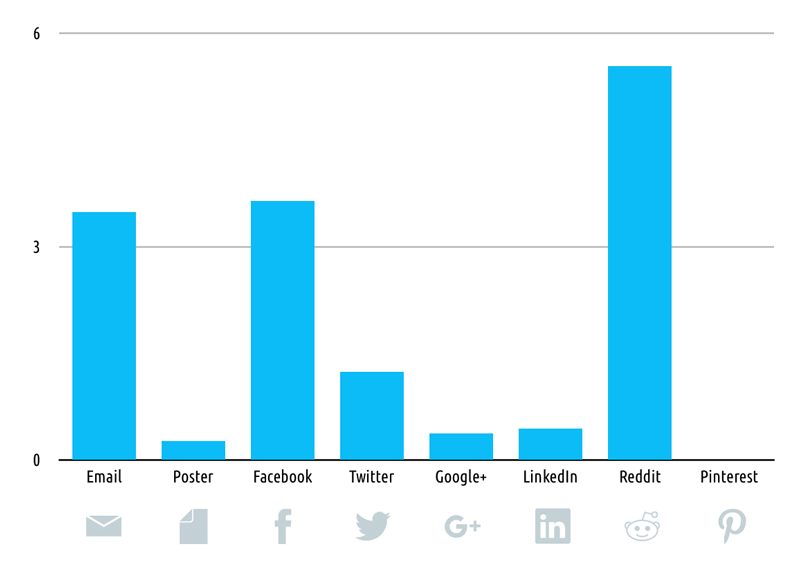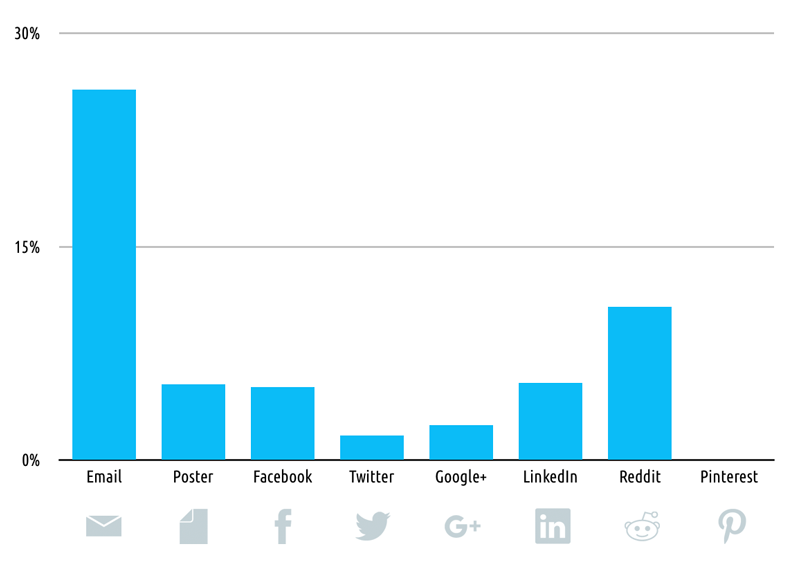How do researchers promote their studies?
05 October 2017
Here at Call for Participants, we have always wanted to build features and develop the platform according to our researchers', in other words, your needs. We continuously assess the site anonymously to discover trends and usage patterns and turn these into product updates. This week, we wanted to share some of these trends with you and demonstrate how you can tailor your promotion for better recruitment.
CfP promotional tools
The CfP site makes it easy for researchers to promote their own research. These tools range from social media integrations to 1-click poster creation and combine well with the active CfP online community to deliver a 1-2 punch for participant recruitment.The tools are combined with analytics tools that give researchers exactly the type of data that you can see here.
What promotion tools do researchers use?

Comparison of CfP promotion tools usage
Source: Call for Participants/Jisc
Out of all studies that are published on CfP, 92.8% use some promotional tool, which is great, because it makes sure you get the best results. Apart from our hugely popular poster printing feature, the usual suspects are used the most - Facebook and Twitter integrations. This makes sense because these are arguably the most popular social media platforms in the world. But does this mean that they get they also maximise your chances of recruiting participants?
Participants' journey
It is important to understand the audience journey that your participants have, right from the early exposure to your promotion, all the way to participation. It is easy to think that putting your promotion out in the world or on a social media platform instantly has people queued to sign up. The power of social media is constantly talked about and this creates a sense that everything posted is likely to go viral. Unfortunately, this is not true. Most posts never make it, but this is not a reason to worry. There is plenty you can do to give your promotions the best possible chance at making it.
Let's talk about conversions. There is a step before your participant goes from seeing your post to taking part - and that is viewing your study. Think of it as the diagram below:

- A potential participant first sees your message on a social media platform or on a poster
- They view your Study Page on CfP and get all the information they need to take part
- They sign up to take part in your research
So how to the promotion tools stack up when we talk about views? (This is the number of people who go from seeing your promotion to viewing your Study Page).

Average views per promotion
Source: Call for Participants/Jisc
Now, the picture looks very different. The number of people a promotion converts to viewers depends on a lot of factors - noise on the platform, the message you wrote, time of posting, the overall size of the platform, size of your audience (followers) etc.
And finally, there are the participants - the number of people view your Study Page and go on to actually take part in your research.

Average participants per promotion
Source: Call for Participants/Jisc
Now, the numbers align again - but we are looking at the total number of participants. Meaning, naturally, the more "popular" channels, in other words, more widely used platforms generate more views and thus more participants. But could you be overlooking a channel that is great for getting participants, but is not so popular?
Importance of conversion
Data shows that channels perform differently when it comes to converting viewers into participants. Some channels have high viewership and some have high participation. There are barriers that people need to cross to make it from seeing your promotional message to looking at your Study Page to taking part. Conversion is the percentage of people that cross this barrier and go from one step to the next in the diagram above.

Average participation conversion rate
Source: Call for Participants/Jisc
Now we see that on some channels, for example, Twitter, people are interested in your study, but not so much in taking part. Is this because they aren't interested in taking part, or are you not reaching the people who are interested in the subject that your research is about? Can you tailor your tweet in a way that reaches that audience and captures their interest? This helps convert a larger amount of people from seeing your promotion to viewing your Study Page.
The CfP Study Page then provides all the required info so that people can easily make the decision whether to take part. Skipping this step and directing people directly to your study means only a small proportion already familiar with the world of research participation has the necessary context to take part. In other words, you eliminate a step but lower the conversion from view to participation.
What does this mean?
So what can you take away to make sure your promotion is effective?
- Tailor the messages that you post through promotional tools to fit the audience who you are sending it to - make use of their interests or alignment with the cause of your research
- Put yourself in the position of the audience, they might not understand why your research is so cool - tell them and tell them in simple terms. Don't use cumbersome academic jargon if you try to capture the interest of the general population in 144 characters - make it simple, but significant.
- Make it easy for them to convert to a participant - tell they why it is important and what is the benefit to them. This can be as simple as helping humanity understand something better. People want to know why they are doing something.
- Use our built-in statistics tools to see how your study is doing with views and participant conversions. Use this knowledge to change the message and promote again on channels that are not doing so well.
Get started with promoting your study now.
Learn how to access promotion tools
